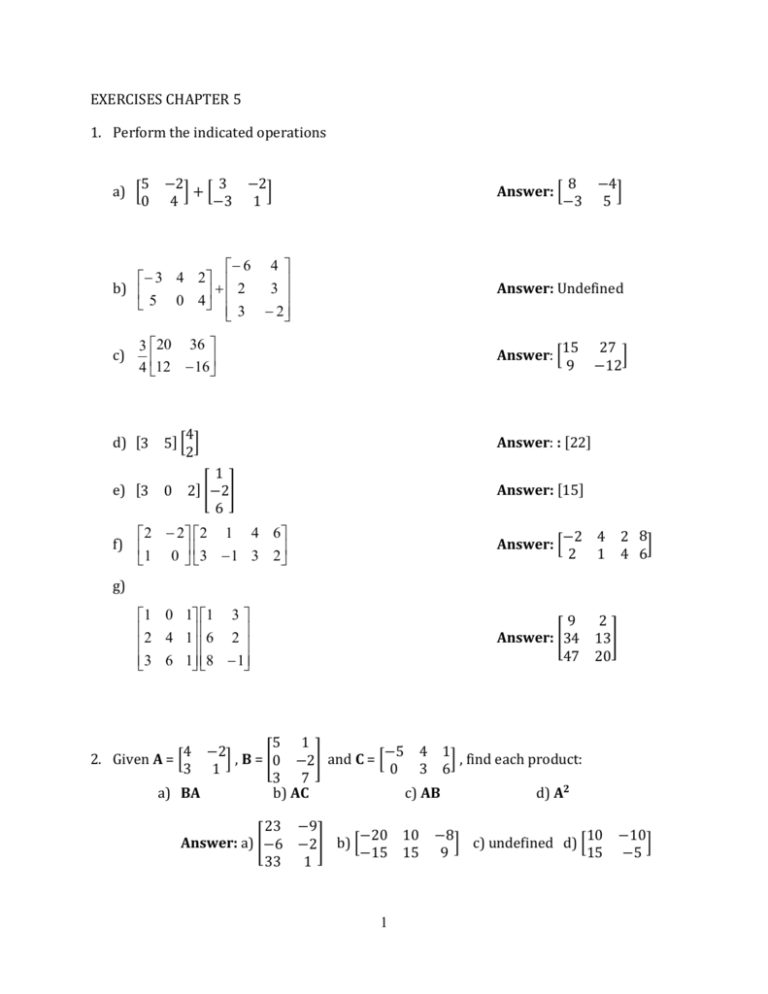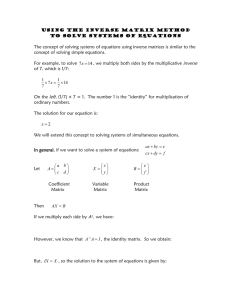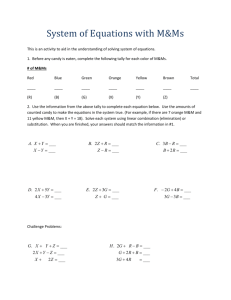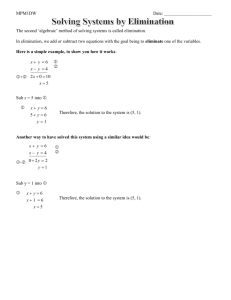Linear Algebra Exercises: Matrices & Equations
advertisement

EXERCISES CHAPTER 5
1. Perform the indicated operations
a) [
3 −2
5 −2
]+[
]
−3 1
0 4
Answer: [
6 4
3 4 2
b)
3
2
5
0
4
3 2
c)
Answer: Undefined
3 20 36
4 12 16
15
Answer: [
9
4
d) [3 5] [ ]
2
27
]
−12
Answer: : [22]
1
2] [−2]
6
e) [3 0
8 −4
]
−3 5
Answer: [15]
2 2 2 1 4 6
f)
1 0 3 1 3 2
Answer: [
−2 4 2 8
]
2 1 4 6
g)
1 0 1 1 3
2 4 1 6 2
3 6 1 8 1
9
Answer: [34
47
2
13]
20
5 1
4 −2
−5 4 1
] , B = [0 −2] and C = [
] , find each product:
3 1
0 3 6
3 7
a) BA
b) AC
c) AB
d) 𝐀𝟐
2. Given A = [
23 −9
−20 10
Answer: a) [−6 −2] b) [
−15 15
33 1
1
−8
10
] c) undefined d) [
9
15
−10
]
−5
4 2
3. Given A =
,B=
3 1
5 1
0 2 , C = 5 4 1 and n = 4 2 .
0 3 6
3 1
3 7
Find each product :a. BA
b. AC
c. AB
d. n 2
23 −9
Answer: a. [−6 −2]
33 1
b. [
−20 10
−15 15
−8
]
9
c. undefined d. [
10 −10
]
15 −5
3 −3 7
−9 5 −8
4. Let 𝑨 = [2 6 −2] and 𝑩 = [ 3 −7 1 ]. Find 𝑨2 − 5𝑩
4 2
5
−1 2
6
76
Answer: [−5
41
1 1
5. .Given A=[0 1
0 1
−38 102
61 −13]
0
19
1
0]. Show that 𝐴2 = 3𝑎 − 2𝐼
2
1 2
, find the values of m and n such that C 2 mC nI 0 .
6. Given C
4 3
Answer: m=-4, n=-5
2
4
0
7. Given 𝑨 = [
],
−3 −1
4 2
2
𝑩= [
] and 𝑪 = [ ]
−7 5
1
a) Find, if possible 𝑨 − 𝑩 , 𝑨𝑪, 𝑨 + 𝑪.
b) Show that 𝑨𝑩 ≠ 𝑩𝑨
𝑎
c) Given 𝑫 = [
6
2
15 2
]. If 𝑘𝑨 + 𝑫 = [
] , find the value of the constants 𝑎, 𝑏 and 𝑘
𝑏
0 −𝑏
0
Answer:𝒂) [
4
−2
8
], [ ], not possible.
−6
−7
𝒄) 𝑎 = 7, 𝑏 = 1, 𝐾 = 2
8. Problems (a) – (d) pertain to be determinant below:
5 −1 −3
|3 4
6|
0 −2 8
Write the minor of each element given:
a. 𝑎11
c. 𝑎12
b. 𝑎33
d. 𝑎23
Write the cofactor of each element given:
e. 𝑎11
g. 𝑎23
f. 𝑎33
h. 𝑎12
Answer: a) |
4 6
5 −1
| b) |
|
−2 8
3 4
e) 44
f) 23
9. Evaluate each determinant in Problems 14(a) – 14(e).
a)
3 1
b)
6 4
1 3
c)
3 1
4
2
4 2
3
3 6
c) |
|
0 8
d)
g) −24
h) 10
5
|
0
−1
|
−2
3 4 2
d) 1 1 5
1
2
2
4 1 2
e) 6 1 0
1 3 4
Answer: a) 2 b) 22 c) -2
10. Solve for x
𝑥 𝑥
a) |
|=−48
−4 4
𝑥 1
b) | 2 3
−1 3
d) 10 e) -26
Answer:-6
1
1|=-5
5
Answer: -¼
1
−1
0
c) |−3 𝑥 − 2
2 | = −5
0
−2 𝑥 + 1
Answer:: 2
1
1
0
11. Given the matrix P = [−2 2𝑥 + 1
4 ]. If |𝑷|=-4, find the value of x.
−1
0
2𝑥 + 3
3
Answer: − 2
−1
12. Find the value of the determinant |𝑥 + 2𝑎
𝑎
𝑥
|1
𝑎
𝑦
2
𝑏
−3
𝑧 + 2𝑐 | if it is known that
𝑐
𝑧
3| =4
𝑐
1
13. Given 𝑨 = [𝑥
𝑝
where
−2
𝑦 + 2𝑏
𝑏
2
𝑦
𝑞
Answer: 4
3
𝑧 ]. If |𝑨| = 4, use properties of determinant to find |𝑩|, |𝑪| and |𝑫|
𝑟
−2
𝑩= [ 𝑝
𝑥
−4 −6
𝑞
𝑟 ],
𝑦
𝑧
1
𝑪 = [𝑥
𝑝
4
2
𝑦
𝑞
0
𝑧 − 3𝑥 ],
𝑟 − 3𝑝
𝑝
𝑫 = [𝑥
𝑝
𝑞
𝑦
𝑞
𝑟
𝑧]
𝑟
Answer: 8, 4, 0
14. Write the row operation(s) that transform(s) A to B and B to C
3 −2 −9 9
𝑨 = [2 3 −1 −2]
1 −1 1
8
1 −1 1 8
𝑩 = [2 3 −1 −2]
3 −2 −9 9
1
𝑪 = [0
0
−1
1
8
5
−3 −18 ]
1 −12 −15
Answer: 𝑟1 ↔ 𝑟3 ,
𝑅2 = 𝑟2 − 2𝑟1
𝑅3 = 𝑟3 − 3𝑟1
15. Solve the system of linear equations
2𝑦 + 𝑧 = 4
𝑥+𝑦 =4
3𝑥 + 3𝑦 − 𝑧 = 10
by using elementary row operations.
Answer:
𝑥 = 3, 𝑦 = 1, 𝑧 = 2
16. Use Gaussian elimination method to solve the following systems of equations.
x y z 3
(a) 2 x 3 y 7 z 0
x 3 y 2 z 17
2 x y 3z 11
(b) x y 1
2 x y 4 z 8
Answer: (𝑎) 𝑥 = 1, 𝑦 = 4, 𝑧 = −2 (𝑏) 𝑥 = 3, 𝑦 = 2, 𝑧 = −1
17. Given a system of equations
x 2z 2
3
x 2 y 3 z
2
x y 2
use Gauss-Jordan elimination method to find the values of x, y and z.
Answer: 𝑥 = 1, 𝑦 = −1, 𝑧 = 1/2
5
18. By using Gauss-Jordan elimination method, determine the values of 𝑥, 𝑦 and 𝑧.
𝑥 + 𝑦 + 𝑧 = 50
2𝑥 − 𝑧 = 1
𝑥 − 3𝑦 + 𝑧 = −10
Answer: 𝑥 = 12, 𝑦 = 15, 𝑧 = 23
19. Use the Gauss-Jordan elimination method to solve the following system of linear
equation.
4𝑥 − 2𝑦 + 3𝑧 = 3
3𝑥 − 𝑦 − 2𝑧 = −10
2𝑥 + 4𝑦 − 𝑧 = −1
Answer: x = −1, 𝑦 = 1, 𝑧 = 3
20. A system of linear equations is written in the form AX=B. The resulting augmented
1 −1 1 8
matrix is [2 3 −1 −2]. Write the coefficient matrix A and the column matrix B.
3 −2 −9 9
𝑥
If X =[𝑦], what is the system of linear equations in terms of x, y and z ?
𝑧
Answer:
𝑥−𝑦+𝑧 =8
2𝑥 + 3𝑦 − 𝑧 = −2
3𝑥 − 2𝑦 − 9𝑧 = 9
−𝑝
2 −1 𝑞
21. Two matrices A and B are given by A = [1 0 1] and B = [−1
3 𝑝 4
−1
3 −1
5 −1]
−1 𝑞
Where p and q are real numbers. Find the values of p, q and k such that
AB = k I where I is a 3X3 identity matrix. Hence, solve the system of linear
−3𝑝𝑥 + 9𝑦 − 3𝑧 = 30
equations given as: { −3𝑥 + 15𝑦 − 3𝑧 = 36
−3𝑥 − 3𝑦 + 3𝑞𝑧 = −18
Answer: 𝑘 = 2, 𝑝 = −1, 𝑞 = 1, 𝑥 = 1, 𝑦 = 2, 𝑧 = −3
6
22. Use Cramer’s Rule to solve the system of equations.
2 x y z 3
x 2 y 4 z 3
x 2 y 3z 4
Answer: 𝑥 = 3, 𝑦 = −2, 𝑧 = 1
23. Solve the system of equation using Cramer’s Rule
a) {
𝑥+𝑦 =8
𝑥−𝑦 =2
Answer: 𝑥 = 5, 𝑦 = 3
b) {
3𝑥 − 𝑦 = 4
5𝑥 + 4𝑦 = 35
Answer: 𝑥 = 3, 𝑦 = 5
c)
𝑥 + 𝑦 − 𝑧 = −6
3𝑥
− 𝑦 + 4𝑧 = 5
{
𝑥 + 5𝑦 − 3𝑧 = −24
Answer: 𝑥 = −1, 𝑦 = −4, 𝑧 = 1
d)
𝑥 + 5𝑦 − 𝑧 = 5
{ 2𝑥 − 5𝑦 + 𝑧 = 1
−3𝑥 + 5𝑦 − 5𝑧 = 1
Answer: 𝑥 = 2, 𝑦 = 5 , 𝑧 = −1
2 x y z 3
e) x 2 y 4 z 3
x 2 y 3z 4
2
Answer: 𝑥 = 3, 𝑦 = −2, 𝑧 = 1
24. Solve problems using Cramer’s rule.
a. 𝑥 + 2𝑦 = 1
𝑥 + 3𝑦 = −1
d. 2𝑥 + 𝑦 = 2
𝑥 − 𝑦 + 𝑧 = −1
𝑥+𝑦+𝑧 =2
b. 5𝑥 + 2𝑦 = −1
2𝑥 − 3𝑦 = 2
e. 𝑥 − 𝑧 = −3
2𝑥 − 𝑦 = −3
𝑥+𝑦+𝑧 =1
c. 𝑥 + 3𝑦 = −3
2𝑦 + 𝑧 = 3
−𝑥 + 3𝑧 = 7
7
Answer: a) 𝑥 = 5, 𝑦 = −2
1
3
1
d) 𝑥 = 4 , 𝑦 = 2 , 𝑧 = 4
b) 𝑥 = 1
1
1
19
7
, 𝑦=−
e) 𝑥 = 4 , 𝑦 = 2 , 𝑧 = −
12
19
c) 𝑥 = −8 , 𝑦 =
5
3
,𝑧 = −
1
3
11
4
25. Given
𝑥−𝑦−𝑧 =1
2𝑥 − 𝑦 + 𝑧 = 2
2𝑥 − 2𝑦 − 𝑧 = 3
Express the above system of equations in form AX = B. Hence solve this system of
equations by using
a) Gauss-Jordan elimination method. (Reduce the augmented matrix to reduced
echelon
form).
b) Cramer’s rule
Anwers: 𝑥 = −1, 𝑦 = −3, 𝑧 = 1
2
2
26. Obtain the inverse matrix of A=[ 0
4
−1 −2
−1
−1].
1
1
1
Answer: [ ⁄2
2
−3
27. Given A= [ 2
−1
0
1⁄
2
1
1
1]
4
−1 1
1
0 ], find 𝐴−1 as a single matrix.
2 −1
Answer: 𝐴−1
8
− 3⁄8
= 3⁄4
5
[ ⁄8
− 1⁄8
5⁄
4
7⁄
8
− 1⁄8
1⁄
4
1
− ⁄8]
1 7
3
3 0
1
5
−7 −1
−8 −2], find 𝑨𝑩. Hence determine 𝐴−1 .
−15 21 5
28. Given 𝑨 = [0 5 2] and 𝑩 = [ 6
2
Answer: [0
0
5
7
1
−2 −2
0 0
2
2 0], [ 3
−4 −1]
15
21
5
0 2
−2
2
2
7 16 10
1 2 6
29. Given A = 1 1 2 and B = 5 11 8 , find AB and hence write
1 1
2 3 1
1
downthe inverse matrix A-1. Use this matrix to find the values of x. y and z given that A
x 1
y = 2
z 3
1
Answer: A-1= 3 B, 𝑥 = 3, 𝑦 = 1, 𝑧 = 0
30. Given
𝑥+𝑦−𝑧 =6
3𝑥 − 4𝑦 + 2𝑧 = −2
2𝑥 + 5𝑦 + 𝑧 = 0
i)
Express the above system of equations in form AX = B.
ii)
Find 𝐴−1 using row operations. Hence solve the system of equations.
Answer: 𝑥 = 2, 𝑦 = 0, 𝑧 = −4
2 1 3
31. Find the cofactor and adjoint of the matrix 5 4 3 . Hence, find the inverse
3 2 1
matrix and solve the system of linear equations
2𝑥 – 𝑦 + 3𝑧 = −25
5𝑥 + 4𝑦 – 3𝑧 = −1
3𝑥 – 2𝑦 – 𝑧 = −17
9
Answer: 𝑥 = 5, 𝑦 = 3, 𝑧 = −4
32.
2
A is the matrix [1
2
2 −1
3 −4].
1 −2
a) Find the determinant of A.
−2 𝑥 −5
b) Given the cofactor matrix of A is [ 𝑦 −2 2 ], determine the values of x, y
−5 7
𝑧
and z.
c) Obtain the adjoint matrix of A and hence find the inverse of A.
Answer: a) -11
b) x = -6, y = 3, z = 4
c)
2
−3
5
11
6
11
2
11
−7
11
5
11
−2
11
−4
[11
11
11 ]
3 2 1
33. Given a matrix A 1 2 3, find its inverse using
4 5 7
(a) adjoint method
(b) row operations,
hence solve the system of equations
3x 2 y z 5
x 2 y 3z 8
4 x 5 y 7 z 7
Answer: 𝑥 = 7/2, 𝑦 = 9/2, 𝑧 = 3/2
2 −5 −3
34. Let 𝑨 = [0 1 −1]. Find
2 4
8
i) the cofactors of A
ii) Adj A
iii) |𝑨|
iv) 𝑨−1
Hence solve the following system of equations:
10
2𝑥 − 5𝑦 − 3𝑧 = 5
𝑦− 𝑧 =1
2𝑥 + 4𝑦 + 8𝑧 = −6
3
7
1
10
1
10
11
5
1
12 28 8
Answer: Adj A = [−2 22 2], |𝑨|= 40, 𝑨−1 = − 20 20
−2 −18 2
3
9
[− 20 − 20
20
1
, x=1, y=0, z=-1
20]
35. Given the system of linear equations
3𝑥 + 2𝑦 = 45
𝑥 + 𝑦 + 𝑧 = 40
4𝑥 − 𝑧 = 0
a) Write down the above equations as a matrix equation in the form AX = B
b) Obtain the adjoint matrix of A and the determinant |𝑨|.
Hence, find A-1. By using A-1, solve for x, y and z.
Answer: |𝑨|=7, 𝑥 = 5, 𝑦 = 15, 𝑧 = 20
36. Given a matrix A =
2 3 0
[−5 0 4], find its inverse using
0 2 1
a) the adjoint method
b) elementary row operations,
2𝑥 + 3𝑦 = 1
hence, solve the system of equations {−5𝑥 + 4𝑧 = −1
2𝑦 + 𝑧 = 2
3 12
8
Answer: inverse of A 5 2 8 , 𝑥 = −19, 𝑦 = 13 , 𝑧 = −24
10 4 15
11









